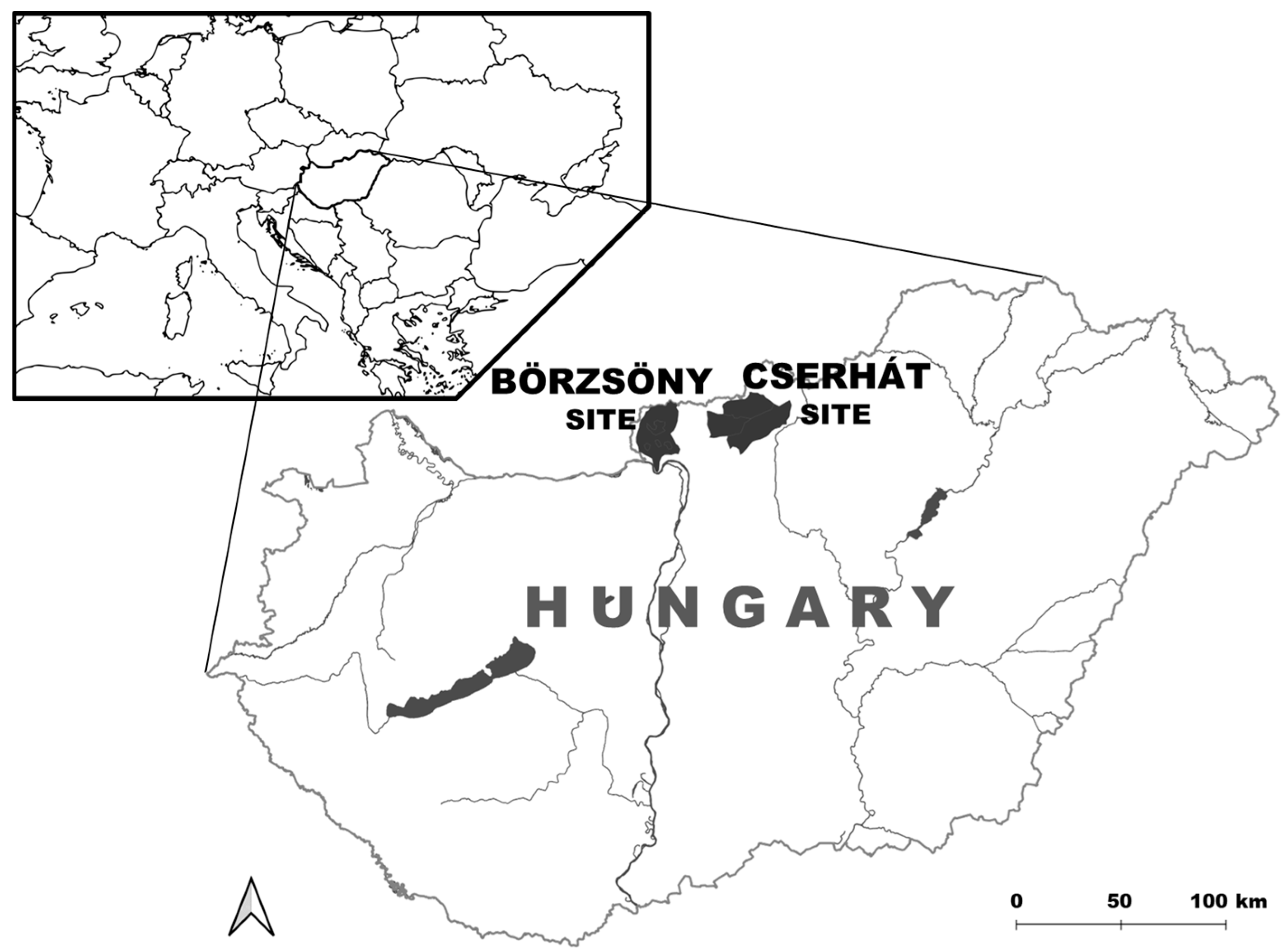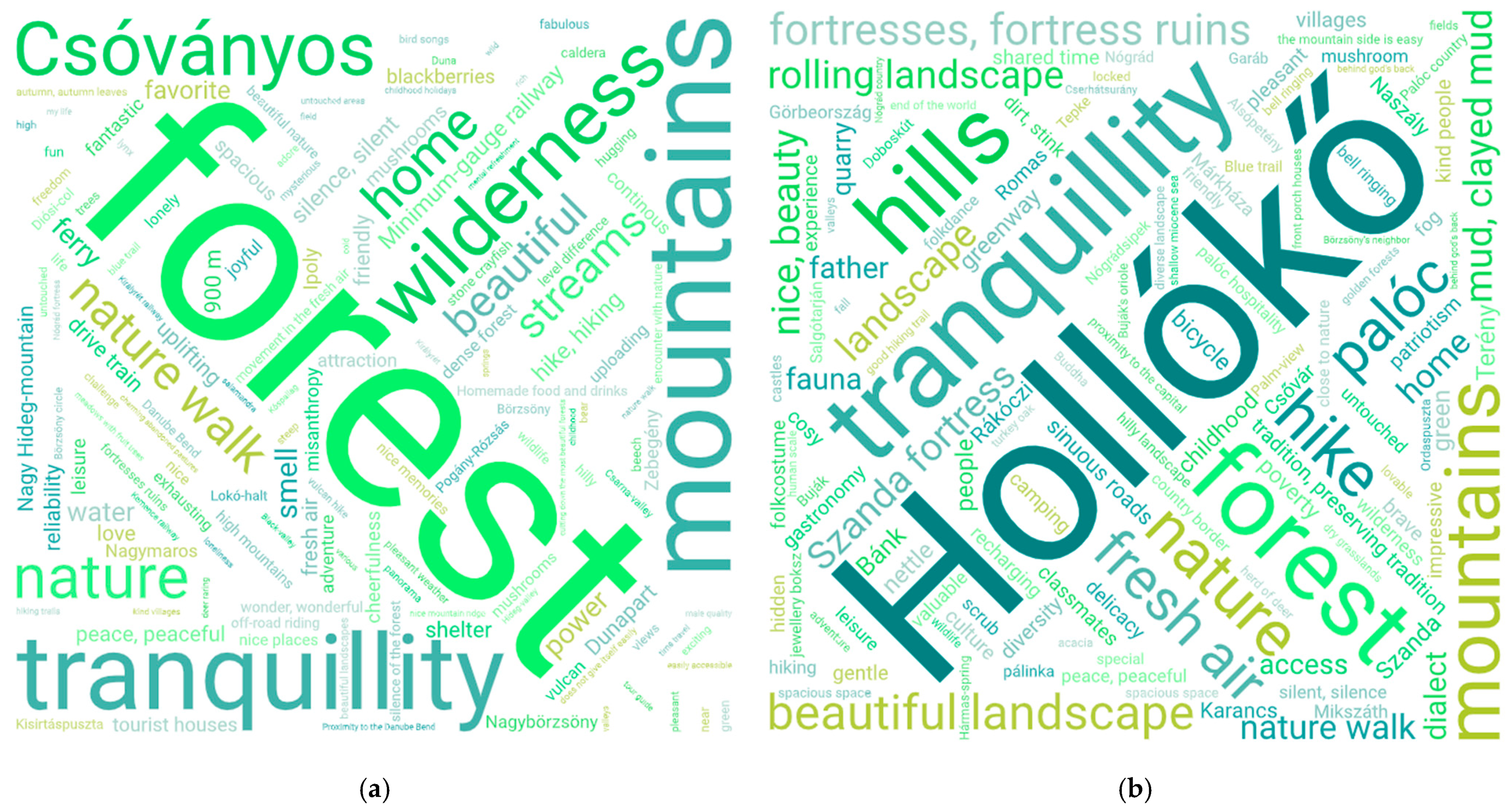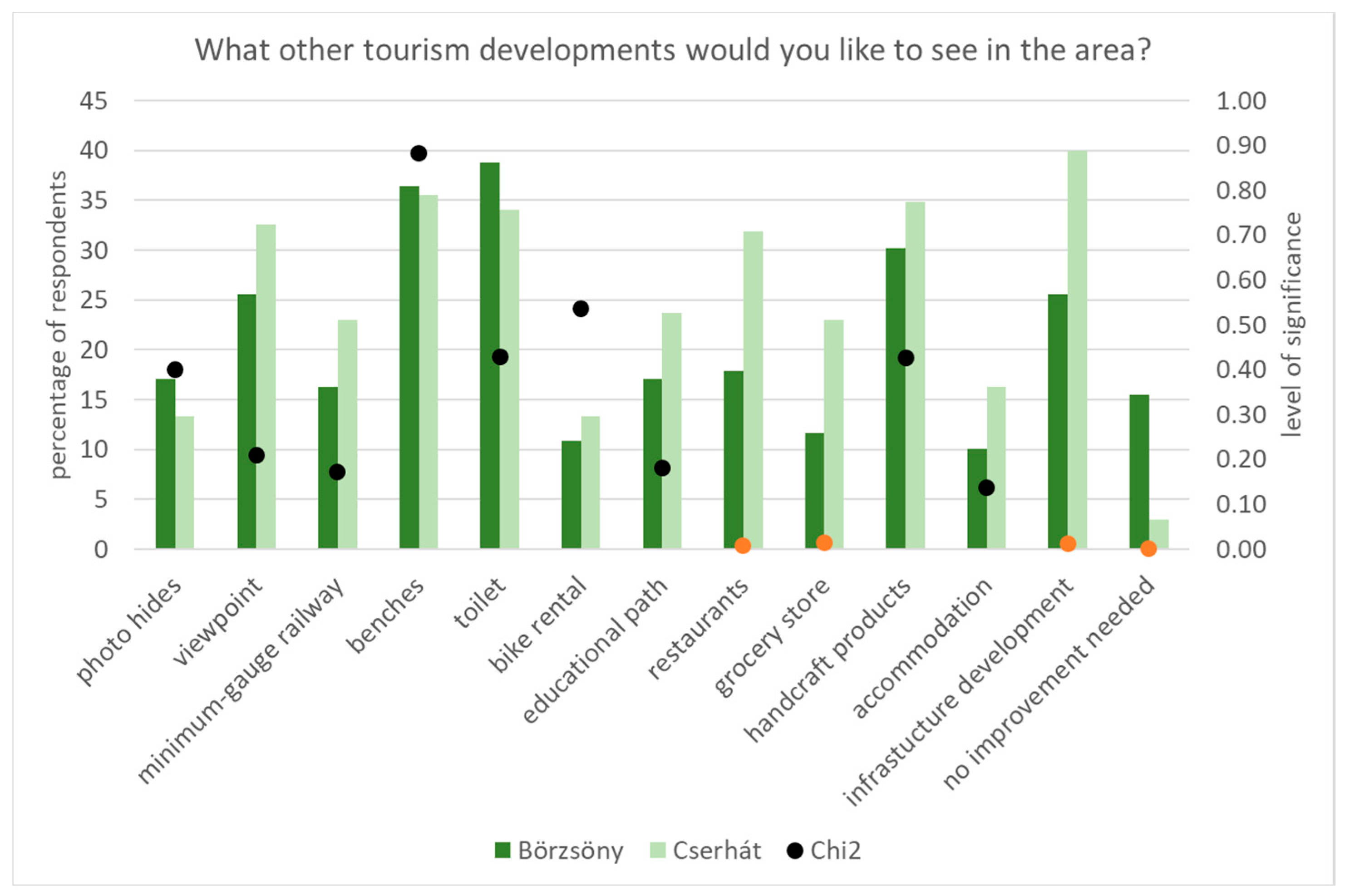Comparison of Nature Tourism in Two Hungarian Forest-Dominated Areas—Results of Visitor Surveys
Abstract
1. Introduction
2. Materials and Methods
2.1. Study Areas
2.1.1. Börzsöny Mountain
2.1.2. Cserhát Nature Park
2.2. Data Gathering and Analysis
3. Results
3.1. Characteristics of the Respondents
3.2. Characteristics of the Visits
3.3. Values of the Area That Attract Visitors
3.4. Development of Nature Related and Other Touristic Infrastructure and Programs
4. Discussion
4.1. Characteristics of the Visits
4.2. Values of the Area That Attract Visitors
4.3. Development of Nature-Related and Other Touristic Infrastructure and Programs
5. Conclusions
Author Contributions
Funding
Data Availability Statement
Acknowledgments
Conflicts of Interest
Appendix A. Questions from the Questionnaires for Tourists (Börzsöny/Cserhát) Analyzed in the Paper
- 1. Visiting habits
- 1.1. How often do you visit the Börzsöny/Cserhát, depending on the season?
| winter | spring | summer | autumn | |
| daily | ||||
| weekly | ||||
| monthly | ||||
| yearly | ||||
| first time | ||||
| no reply |
- 1.2. How long do you usually stay in the Börzsöny/Cserhát?
- a day
- a week
- various
- live here
- 1.3. With whom do you usually visit the Börzsöny/Cserhát? (You can select more than one answer.)
- with family member
- with friends
- alone
- with a group
- other
- 1.4. How do you arrive to the Börzsöny/Cserhát? (You can select more than one answer.)
- by car
- by train
- by bus
- by bike
- walk
- other
- 1.5. How satisfied are you with the journey times of trains?
- 1—very dissatisfied
- 2—not satisfied
- 3—it is convenient
- 4—satisfied
- 5—very satisfied
- 1.6. How satisfied are you with the journey times of buses?
- 1—very dissatisfied
- 2—not satisfied
- 3—it is convenient
- 4—satisfied
- 5—very satisfied
- 1.7.A. Which villages do you usually visit on your trip to Börzsöny? (You can select more than one answer.) (only in the Börzsöny questionnaire)
- Nagymaros
- Kismaros
- Zebegény
- Szokolya
- Szob
- Nagybörzsöny
- Kemence
- Drégelypalánk
- Diósjenő
- Nógrád
- other
- 1.7.B. Which villages do you usually visit on your trip to Cserhát? (You can select more than one answer.) (only in the Cserhát questionnaire)
- Hollókő
- Rimóc
- Varsány
- Nagylóc
- Buják
- Alsótold
- Magyarnándor
- Mohora
- Terény
- Szanda
- Cserhátsurány
- Cserháthaláp
- Ecseg
- Nógrádsipek
- other
- 1.8. What are the purposes of visiting the Börzsöny/Cserhát? (You can select more than one answer.)
- hiking
- nature walk
- cycling
- horse riding
- recreation
- photography
- hunting
- research
- exploring cultural values
- programs
- other
- 1.9. Why did you choose the Börzsöny/Cserhát? (You can select more than one answer.)
- landscape
- pleasant climate
- easy access
- hospitable residents
- low prices
- high-quality services
- cultural values
- low tourist numbers
- fresh air
- other
- 1.10. What kind of accommodation do you stay in? (You can select more than one answer.)
- hotel
- aparthotel
- apartment
- guest house
- cabin
- camping
- own holiday cottage
- friend’s house
- not staying
- local people
- other
- 2. Nature and landscape
- 2.1. What are the three words that first come to mind about Börzsöny/Cserhát?
- 2.2. Do you go hiking?
- yes
- no
- no reply
- 2.3. What does hiking provide you? (You can select more than one answer.)
- leisure
- the joy of movement
- fresh air
- inspiration
- loneliness
- company
- silence, tranquility
- knowledge
- energizing
- rest
- recreation
- collecting sth.
- panorama
- other
- 2.4. What is the condition of hiking trails in the Börzsöny/Cserhát?
- 1—very bad, could be improved a lot
- 2—bad, could be improved
- 3—medium, fair
- 4—good
- 5—very good
- 3. Development needs
- 3.1. Which of the tourist opportunities offered by Börzsöny/Cserhát do you use? (You can select more than one answer.)
- educational path
- forest school
- hiking trail
- tour guide
- photo hides
- viewpoint
- bike rental
- exhibition
- restaurants
- grocery store
- accommodation
- no reply
- other
- 3.2. What nature related tourism developments would you like to see in the Börzsöny/Cserhát? (You can select more than one answer.)
- horse riding
- forest school
- visitor center
- botanical tour
- geological tour
- zoological tour
- landscape history tour
- photography tour
- mushroom, wild plant and herbal tour
- children’s programs
- no improvement needed
- no reply
- other
- 3.3. What other tourism developments would you like to see in the Börzsöny/Cserhát? (You can select more than one answer.)
- photo hides
- viewpoint
- minimum-gauge railway
- benches
- toilet
- beach
- bike rental
- educational path
- restaurants
- grocery store
- handcraft products
- accommodation
- infrastructure development
- no improvement needed
- no reply
- other
- 4. Demographics
- 4.1. Please enter the municipality where you live:
- 4.2. What is your gender?
- woman
- man
- 4.3. How old are you?under 18 years
- 19–30
- 31–40
- 41–50
- 51–60
- 4.4. What is your highest level of education?
- primary school
- secondary school
- higher education
- other
- 4.5. What is the monthly net income per person in your family?
- 50,001–100,000 HUF
- 100,001–150,000 HUF
- 150,001–300,000 HUF
- 300,001–500,000 HUF
- above 500,000 HUF
- no reply
References
- FOREST EUROPE. State of Europe’s Forests 2020. Available online: https://foresteurope.org/state-of-europes-forests/ (accessed on 25 August 2024).
- KSH 15.1.2.14. Erdők Vármegye És Régió Szerint. Available online: https://www.ksh.hu/stadat_files/kor/hu/kor0058.html (accessed on 25 August 2024).
- NFK (Nemzeti Földügyi Központ). Magyarország Erdeinek Összefoglaló Adatai. 2022. Available online: https://nfk.gov.hu/download.php?id_file=45191 (accessed on 25 August 2024).
- NFK (Nemzeti Földügyi Központ). Erdőterületek Megoszlása Szektorok Szerint. 2022. Available online: https://nfk.gov.hu/download.php?id_file=45151 (accessed on 25 August 2024).
- Sotirov, M.; Arts, B. Integrated Forest Governance in Europe: An Introduction to the Special Issue on Forest Policy Integration and Integrated Forest Management. Land Use Policy 2018, 79, 960–967. [Google Scholar] [CrossRef]
- Pilli, R.; Pase, A. Forest Functions and Space: A Geohistorical Perspective of European Forests. IForest-Biogeosci. For. 2018, 11, 79–89. [Google Scholar] [CrossRef]
- Lier, M.; Köhl, M.; Korhonen, K.T.; Linser, S.; Prins, K.; Talarczyk, A. The New EU Forest Strategy for 2030: A New Understanding of Sustainable Forest Management? Forests 2022, 13, 245. [Google Scholar] [CrossRef]
- Brockerhoff, E.G.; Barbaro, L.; Castagneyrol, B.; Forrester, D.I.; Gardiner, B.; González-Olabarria, J.R.; Lyver, P.O.; Meurisse, N.; Oxbrough, A.; Taki, H.; et al. Forest Biodiversity, Ecosystem Functioning and the Provision of Ecosystem Services. Biodivers. Conserv. 2017, 26, 3005–3035. [Google Scholar] [CrossRef]
- Ciesielski, M.; Stereńczak, K. What Do We Expect from Forests? The European View of Public Demands. J. Environ. Manag. 2018, 209, 139–151. [Google Scholar] [CrossRef] [PubMed]
- Csákvári, E.; Fabók, V.; Babai, D.; Dósa, H.; Kisné Fodor, L.; Jombach, S.; Kelemen, E.; Tormáné Kovács, E.; Könczey, R.; Mártonné Máthé, K.; et al. A gyalogos természetjárás és gombászás mint kulturális ökoszisztéma-szolgáltatások értékelése–Az ökoszisztéma-állapottól a ténylegesen igénybe vett ökoszisztéma-szolgáltatás értékelésig. A közösségi jelentőségű természeti értékek hosszú távú megőrzését és fejlesztését, valamint az EU biológiai sokféleség stratégia 2020 célkitűzéseinek hazai szintű megvalósítását megalapozó stratégiai vizsgálatok projekt, Ökoszisztéma-szolgáltatások projektelem. Budapest, Agrárminisztérium 119p. 2021. Available online: https://termeszetem.hu/files/download/documents/document_img/100/?2022-01-07%2000:16:28 (accessed on 25 August 2024).
- Mártonné Máthé, K.; Császár, Z. Valóban Aktív a Magyar Lakosság? Aktív És Ökoturisztikai Keresletet És Motivációt Felmérő Kutatás. Tur. Bull. 2019, 19, 45–57. [Google Scholar] [CrossRef]
- Széchy, A.; Szerényi, Z. Valuing the Recreational Services Provided by Hungary’s Forest Ecosystems. Sustainability 2023, 15, 3924. [Google Scholar] [CrossRef]
- KSH 27.1.1.27. Turizmus Szatellit Számlák. Available online: https://www.ksh.hu/stadat_files/tur/hu/tur0031.html (accessed on 19 September 2024).
- Edwards, D.M.; Jay, M.; Jensen, F.S.; Lucas, B.; Marzano, M.; Montagné, C.; Peace, A.; Weiss, G. Public Preferences Across Europe for Different Forest Stand Types as Sites for Recreation. Ecol. Soc. 2012, 17, art27. [Google Scholar] [CrossRef]
- Dudek, T. Recreational potential as an indicator of accessibility control in protected mountain forest areas. J. Mt. Sci. 2017, 14, 1419–1427. [Google Scholar] [CrossRef]
- Šodková, M.; Purwestri, R.C.; Riedl, M.; Jarský, V.; Hájek, M. Drivers and Frequency of Forest Visits: Results of a National Survey in the Czech Republic. Forests 2020, 11, 414. [Google Scholar] [CrossRef]
- Paletto, A.; Guerrini, S.; De Meo, I. Exploring visitors’ perceptions of silvicultural treatments to increase the destination attractiveness of peri-urban forests: A case study in Tuscany Region (Italy). Urban For. Urban Green. 2017, 27, 314–323. [Google Scholar] [CrossRef]
- Abildtrup, J.; Garcia, S.; Olsen, S.B.; Stenger, A. Spatial Preference Heterogeneity in Forest Recreation. Ecol. Econ. 2013, 92, 67–77. [Google Scholar] [CrossRef]
- Eriksson, L.; Nordlund, A.; Olsson, O.; Westin, K. Beliefs about Urban Fringe Forests among Urban Residents in Sweden. Urban For. Urban Green. 2012, 11, 321–328. [Google Scholar] [CrossRef]
- Sklodowski, J.; Gołos, P. Value of Leisure−related Function of Forest in View of the Results of Nationwide Survey in Poland Wartość Rekreacyjnej Funkcji Lasu w Świetle Wyników Ogólnopolskiego Badania Opinii Społecznej. Sylwan 2016, 160, 759–766. [Google Scholar]
- Benkhard, B. Túrázók a Pilis És a Visegrádi-Hegység Területén: A Megközelítés Problémája. Tur. Bull. 2021, 21, 5–13. [Google Scholar] [CrossRef]
- Hegetschweiler, K.T.; Plum, C.; Fischer, C.; Brändli, U.B.; Ginzler, C.; Hunziker, M. Towards a comprehensive social and natural scientific forest-recreation monitoring instrument—A prototypical approach. Landsc. Urban Plan. 2017, 167, 84–97. [Google Scholar] [CrossRef]
- Hegetschweiler, K.T.; Stride, C.B.; Fischer, C.; Ginzler, C.; Hunziker, M. Integrating Recreation into National Forest Inventories–Results from a Forest Visitor Survey in Winter and Summer. J. Outdoor Recreat. Tour. 2022, 39, 100489. [Google Scholar] [CrossRef]
- Becse, A.; Mezősi, G.; Ádám, L.; Juhász, Á.; Marosi, S.; Somogyi, S.; Szilárd, J.; Ambrózy, P.; Konkolyné, B.Z.; Király, G.; et al. Magyarország Kistájainak Katasztere; Dövényi, Z., Ed.; MTA Földrajztudományi Kutatóintézet: Budapest, Hungary, 2010; ISBN 978-963-9545-29-8. [Google Scholar]
- Benkhard, B. Determination of Tourist Flow Patterns in a Low Mountain Study Area. Tour. Manag. Stud. 2018, 14, 19–31. [Google Scholar] [CrossRef]
- Füri, A. Ahol a cincérek élnek–a Duna-Ipoly Nemzeti Park. In Vadregényes erdőtáj: A Börzsöny; Ipoly Erdő Zrt.: Balassagyarmat, Hungary, 2019; pp. 533–541. ISBN 978-963-88414-1-4. [Google Scholar]
- Standovár, T.; Bán, M.; Kézdy, P. Erdőállapot-Értékelés Középhegységi Erdeinkben; Standovár, T., Bán, M., Kézdy, P., Eds.; Rosalia; Duna-Ipoly Nemzeti Park Igazgatóság: Budapest, Hungary, 2017; ISBN 978-615-5241-20-8. [Google Scholar]
- Zoltán, J. A Duna-Ipoly Nemzeti Park Igazgatóság Hetéves Fejlesztési Terve (2009–2014). Available online: http://dinp.nemzetipark.gov.hu/_user/browser/File/6eves_terv.doc (accessed on 25 August 2024).
- Pogány-Rózsás Erdőrezervátum|Erdőrezervátum Program. Available online: https://erdorezervatum.hu/Pogany-Rozsas (accessed on 25 August 2024).
- A Börzsöny. Available online: https://www.dunaipoly.hu/hu/helyek/vedett-teruletek/duna-ipoly-nemzeti-park/a-borzsony (accessed on 25 August 2024).
- Karátson, D. Tűzből született hegyvilág–időutazás a földtani múltban. In Vadregényes Erdőtáj–A Börzsöny; Ipoly Erdő Zrt.: Balassagyarmat, Hungary, 2019; pp. 15–40. ISBN 978-963-88414-1-4. [Google Scholar]
- Führer, E.; Kovácsevics, P. (Eds.) Magyarország Erdészeti Tájai 2. Északi-Középhegység Erdészeti Tájcsoport; Nemzeti Élelmiszerlánc-biztonsági Hivatal (NÉBIH): Budapest, Hungary, 2017; ISBN 978-615-5747-03-8. [Google Scholar]
- Tímár, G. A megszakíthatatlan erdőrengeteg csodái–A Börzsönyi erdők. In Vadregényes Erdőtáj–A Börzsöny; Ipoly Erdő Zrt.: Balassagyarmat, Hungary, 2019; pp. 253–265. ISBN 978-963-88414-1-4. [Google Scholar]
- Nagy, J. Védett és védendő értékek a lombozat alatt. In Vadregényes Erdőtáj–A Börzsöny; Ipoly Erdő Zrt.: Balassagyarmat, Hungary, 2019; pp. 171–197. ISBN 978-963-88414-1-4. [Google Scholar]
- Vojnits, A.; Csóka, G. A havasi cincértől a gímbikáig–Változatos állatvilág. In Vadregényes Erdőtáj–A Börzsöny; Ipoly Erdő Zrt.: Balassagyarmat, Hungary, 2019; pp. 199–252. ISBN 978-963-88414-1-4. [Google Scholar]
- Benkhard, B.; Előd, R.; Mártonné, E. Restrictions or Possibilities?: Visitor Management in the Börzsöny Landscape Unit of Danube-Ipoly National Park (Hungary). Turizam 2018, 22, 84–94. [Google Scholar] [CrossRef][Green Version]
- Jarvis, A.; Reuter, H.I.; Nelson, A.; Guevara, E. Hole-Filled SRTM for the Globe Version 4. Available from the CGIAR-CSI SRTM 90m Database. 2008. Available online: https://srtm.csi.cgiar.org/ (accessed on 5 January 2024).
- Horváth, R.; Kiss, G.; Szilvácsku, Z. Natúrparkok Magyarországon; Magyar Natúrpark Szövetség: Kimle, Hungary, 2014; Available online: https://kesztolc.hu/data/attachments/2018/12/07/054459/Nat%C3%BArparkok_Magyarorsz%C3%A1gon_kiadv%C3%A1ny.pdf (accessed on 25 August 2024).
- Csorba, P. Magyarország Kistájai; Meridián Táj- és Környezetföldrajzi Alapítvány: Debrecen, Hungary, 2021; ISBN 978-963-89712-4-1. [Google Scholar]
- Harmos, K.; Csordás, Á.; Ferenczy, K.; Forstner, A.; Ispán, D.; Ispánné Péter, É.; Jávor, K.; Pongrácz, Á.; Szandai, J.; Pekár, I.; et al. A Cserhát Natúrpark Szakmai Koncepciója. 2009. Available online: http://cserhatnaturpark.hu/wp-content/uploads/2015/01/Szakmai-Koncepc.09.pdf (accessed on 25 August 2024).
- Magyar, Z. A Magyar Népi Kultúra Régiói. II. Felföld, Erdély, Moldva; A Magyar Népi Kultúra Régiói; M-érték Kiadó Kft.: Budapest, Hungary, 2011; Volume 2, ISBN 978-963-9889-99-6. [Google Scholar]
- Available online: https://naturparkok.hu/cserhat-naturpark/ (accessed on 26 September 2024).
- Available online: http://cserhatnaturpark.hu (accessed on 26 September 2024).
- Pekár, I.; Harmos, K.; Ispánné Péter, É. Képek a Cserhát Natúrparkból; Cserhát Natúrparkért Közhasznú Alapítvány: Hollókő, Hungary, 2014. [Google Scholar]
- Kérdőívek Létrehozása: LimeSurvey. Available online: https://www.limesurvey.org/hu (accessed on 29 August 2024).
- Newing, H.; Eagle, C.M.; Puri, R.K.; Watson, C.W. Conducting Research in Conservation. Social Science Methods and Practice; Routledge: Abingdon, UK, 2011; 376p. [Google Scholar]
- WordArt. Available online: https://wordart.com/create (accessed on 29 August 2024).
- Babbie, E.R. The Practice of Social Research, 13th ed.; Wadsworth Cengage Learning: Belmont, CA, USA, 2013; ISBN 978-1-133-04979-1. [Google Scholar]
- Skłodowski, J.; Gołos, P.; Skłodowski, M.; Ożga, W. The Preferences of Visitors to Selected Forest Areas for Tourism and Recreational Purposes. For. Res. Pap. 2013, 74, 293–305. [Google Scholar] [CrossRef]
- Mizaras, S.; Kavaliauskas, M.; Činga, G.; Mizaraitė, D.; Belova, O. Socio-Economic Aspects of Recreational Use of Forests in Lithuania. Balt. For. 2015, 21, 308–314. [Google Scholar]
- Pichlerová, M.; Önkal, D.; Bartlett, A.; Výbošťok, J.; Pichler, V. Variability in Forest Visit Numbers in Different Regions and Population Segments before and during the COVID-19 Pandemic. Int. J. Environ. Res. Public Health 2021, 18, 3469. [Google Scholar] [CrossRef] [PubMed]
- Bartczak, A.; Englin, J.; Pang, A. When Are Forest Visits Valued the Most? An Analysis of the Seasonal Demand for Forest Recreation in Poland. Environ. Resour. Econ. 2012, 52, 249–264. [Google Scholar] [CrossRef]
- Komossa, F.; Van Der Zanden, E.H.; Schulp, C.J.E.; Verburg, P.H. Mapping Landscape Potential for Outdoor Recreation Using Different Archetypical Recreation User Groups in the European Union. Ecol. Indic. 2018, 85, 105–116. [Google Scholar] [CrossRef]
- Ciesielski, M.; Tkaczyk, M.; Haidt, A.; Szewczyk, M.; Waraksa, P. The use of camera traps for identifying various types of forest recreational activities on the example of Wdecki Landscape Park. Acta Sci. Pol. Adm. Locorum 2023, 22, 19–32. [Google Scholar] [CrossRef]
- Dudek, T. Recreation in suburban forests–monitoring the distribution of visits using the example of Rzeszów. Ann. For. Res. 2024, 67, 131–141. [Google Scholar] [CrossRef]
- Getzner, M.; Meyerhoff, J. The Benefits of Local Forest Recreation in Austria and Its Dependence on Naturalness and Quietude. Forests 2020, 11, 326. [Google Scholar] [CrossRef]
- Ristić, V.; Trišić, I.; Štetić, S.; Nechita, F.; Candrea, A.N.; Majstorović, N.; Tomašević, V. Importance of Forest Ecosystem within Important Plant Areas (IPAs) for the Development of Nature-Based Tourism—A Case Study of Fruška Gora National Park. Forests 2024, 15, 1213. [Google Scholar] [CrossRef]
- Gołos, P. Selected Aspects of the Forest Recreational Function in View of Its Users. For. Res. Pap. 2013, 74, 257–272. [Google Scholar] [CrossRef][Green Version]
- Hegetschweiler, K.T.; Rusterholz, H.P.; Baur, B. Fire place preferences of forest visitors in northwestern Switzerland: Implications for the management of picnic sites. Urban For. Urban Green. 2007, 6, 73–81. [Google Scholar] [CrossRef]













Disclaimer/Publisher’s Note: The statements, opinions and data contained in all publications are solely those of the individual author(s) and contributor(s) and not of MDPI and/or the editor(s). MDPI and/or the editor(s) disclaim responsibility for any injury to people or property resulting from any ideas, methods, instructions or products referred to in the content. |
© 2024 by the authors. Licensee MDPI, Basel, Switzerland. This article is an open access article distributed under the terms and conditions of the Creative Commons Attribution (CC BY) license (https://creativecommons.org/licenses/by/4.0/).
Share and Cite
Ferencz-Havel, A.; Saláta, D.; Orosz, G.; Halász, G.; Tormáné Kovács, E. Comparison of Nature Tourism in Two Hungarian Forest-Dominated Areas—Results of Visitor Surveys. Forests 2024, 15, 1856. https://doi.org/10.3390/f15111856
Ferencz-Havel A, Saláta D, Orosz G, Halász G, Tormáné Kovács E. Comparison of Nature Tourism in Two Hungarian Forest-Dominated Areas—Results of Visitor Surveys. Forests. 2024; 15(11):1856. https://doi.org/10.3390/f15111856
Chicago/Turabian StyleFerencz-Havel, Alexandra, Dénes Saláta, György Orosz, Gergely Halász, and Eszter Tormáné Kovács. 2024. "Comparison of Nature Tourism in Two Hungarian Forest-Dominated Areas—Results of Visitor Surveys" Forests 15, no. 11: 1856. https://doi.org/10.3390/f15111856
APA StyleFerencz-Havel, A., Saláta, D., Orosz, G., Halász, G., & Tormáné Kovács, E. (2024). Comparison of Nature Tourism in Two Hungarian Forest-Dominated Areas—Results of Visitor Surveys. Forests, 15(11), 1856. https://doi.org/10.3390/f15111856





